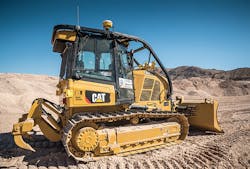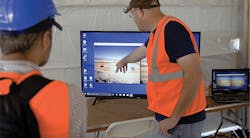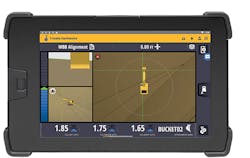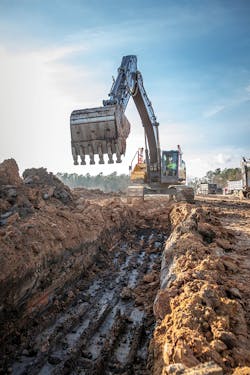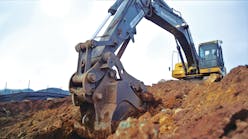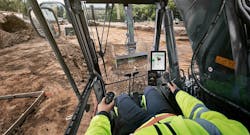Interest, innovation, and excitement in machine control—and by extension autonomy—are on the rise in the construction industry.
There’s been a marked acceleration in contractor engagement and a desire to be involved in the advancement of the technological capabilities and testing of incremental solutions, particularly in light of workforce challenges and a heightened safety focus on job sites.
Where are we now and what should contractors be thinking about in terms of operations, practices, and data workflows to prepare for the emerging autonomous world?
Leveling Out
The construction industry has realized considerable advancement in the development of autonomous solutions, drawing from advancements in agriculture and mining.
The Society of Automotive Engineers (SAE) defines levels from 1–5 for automated driving systems, ranging from complete driver control to full autonomy. Using the SAE definitions, the levels of automation in construction in the last 12 months have pushed from level 2, automated steering and acceleration/deceleration with driver assistance, to level 3, driver present but no driver assistance necessary in certain conditions.
Of note, Level 4 is fully autonomous, safety-critical driving functions along with the ability to monitor roadway conditions under specific scenarios, while Level 5 is a fully-autonomous system that performs like a human in every driving scenario.
In terms of progression through the levels of autonomous systems, the mining and agriculture sectors are more advanced than construction sectors. Mining has the advantage of working in a highly production-oriented, controlled environment. Even two years ago, Cat’s autonomous fleet of Cat 793F trucks was working alongside manned trucks at a mining complex. Similarly, agriculture is realizing exponential leaps in advancement because of the controlled environment of a field as well as that industry’s focus on open standards for integration.
However, construction is a fluid environment where every project is unique in scope, scale, and location. That said, there’s been a considerable progression from level 2 to 3 over the past year, at least in terms of proof-of-concept, and in some cases, a move to level 4 to deliver true driverless features. Automation capabilities in the construction space have largely focused on blade and steering control. These solutions incorporate sense and avoid detection sensors, as well as geofencing capabilities to confine movement to a defined area, along with other safety features and tele-operated observer controls.
Reducing the number of people working alongside machinery is one sure way to improve job site safety. Grade control solutions have reduced or eliminated the need for a survey crew to stand by to verify progress while work is ongoing.
Equipment collision avoidance technology is another step along the autonomous road that will become standard on equipment, much like backup cameras on passenger cars. With radar and cameras, heavy equipment machines will be fitted with technology that can stop a piece of equipment before it hits powerlines or runs into something out of the ordinary on the job site.
Specific to equipment, Trimble believes that autonomous compactors will become reality sooner than other equipment solutions, largely because of the clear ROI that can be achieved with the ability to directly measure accuracy, quality, and speed of surface compaction, which directly relates to cost of ownership.
Autonomous compactors will open the door for the adoption of increasingly autonomous excavators, dozers, and other pieces of equipment. An example of the stepped improvement move to full autonomy is the Trimble Earthworks “automatics” functionality for excavators. When the excavator is placed in “Autos” or automatics mode, the operator controls the stick, and Trimble Earthworks controls the boom and bucket to stay on grade. More recently, the automatic guidance was introduced for tiltrotator attachments on excavators. However, the larger focus in the near term is on tele-operation or remotely controlled machinery.
Tele-Operations
Pioneering developers and contractors are working on hybrid autonomous/tele-operated job sites, particularly for earthwork activities, to improve productivity and job site safety.
Consider the construction of a banked slope. An autonomous machine can be programmed to conduct a repetitive task, but when it gets to the corner, the necessary movement might be too complicated, so that activity will transfer to the remote operator.
Tele-operated solutions are a reality today. Trimble demonstrated the operation of an autonomous dozer at its Trimble Dimensions user conference last year that was controlled by an operator standing in a tent 100 yards away.
Of course, automating the construction workflow is more than just automating a machine. The next step will be coordination of multiple machines, different types of machines, and delivering more of a data-driven site—efforts that are certainly in the works today.
A critical part of the process will be the development of standards for digital data in construction that include the autonomy element. These standards will set a required level of integrity for safe and effective steering, velocity, braking, and other autonomous operations. The agriculture industry has already begun this effort—the construction industry must follow suit.
Taking the First Step
True autonomous machine control is certainly a progression—but there is value in the developments available today for every contractor. Semi-automatic excavators have been out for some time, as have dozers, motor graders, and paving machines.
The ability to automatically control blades and buckets through 3D models and GPS is expected to become the norm in the construction industry as manufacturers incorporate the functionality directly into the machines and technology providers develop necessary connections to add machine control capabilities in the aftermarket. Manufacturers are working more closely with technology providers like Trimble to advance the technology on their machines from the factory.
For those looking to take advantage of the productivity and efficiency improvements offered by these solutions today, step one would be to adopt machine control. Machine control technology has been shown to help skilled operators complete tasks faster with the same or better quality and accuracy. It also opens opportunities to less skilled operators, enabling them to do the job that would have required a skilled operator in the past.
In today’s market, a contractor of any size can gain almost immediate value in productivity with machine control technology, while setting themselves up to take advantage of future autonomous capabilities. Some contractors are realizing double-digit improvements in productivity. One company estimated that the surveyor and field crews saved three days each on the job—at least 40 hours—by using semi-automated boom and bucket operations to dig to a prescribed design elevation.
Step two is to establish data management best practices.
Digital Dilemmas
The ultimate goal of automation and technology-enabled solutions in construction is to move from digital construction to connected intelligent construction. Intelligent construction is all about improving productivity—time, cost, and quality—with help from technology. Autonomous operation is an important facet of that process.
But the digital model is the lifeblood of conventional and autonomous solutions. Every contractor should be building the necessary infrastructure for effective real-time data management. All of the 3D and planning data must be brought together effectively to optimize the way work is done to improve timing and quality.
The value is less about a connected machine, and more about strategic controls, intelligence, and an overall connected, efficient workflow. Intelligent construction workflows don’t just enable a more efficient, productive, safe job site; these workflows also enable profitability when tied to financial data. Already we can use machine learning algorithms to derive performance metrics and facilitate real-time decision making.
Industry-Wide Focus
Autonomy is coming to the construction space.
In this time of transformation, industry professionals must begin to understand how their business, operations, and tools need to change to compete. The process is a group effort. No one company can deliver every element of a solution, which is why industry leaders are partnering to deliver the necessary operational, technical, and strategic controls as well as the right data for effective and safe machine performance.
Like every project ever designed and constructed, delivering truly autonomous construction activities is a team sport—get involved and help innovate the future. It will be here before you know it.
